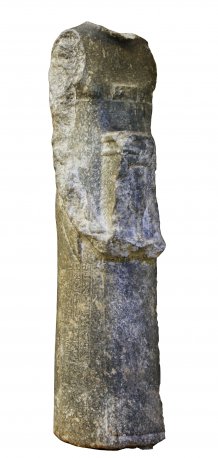Statue of Horpakhepesh
Hieroglyphs
Statue of Horpakhepesh [ edit ]
Although the head is now missing and the hieroglyphic inscriptions are scarcely visible, this statue is an important private monument of Ptolemaic Egypt. The Egyptian name of the statue's owner was Horpakhepesh ("Horus is my strong-arm"), but he also used the Greek name Apollonios on other monuments. Horpakhepesh wears a baggy-sleeved tunic beneath a wrap-around robe, and carries a shrine containing a representation of the feline goddess Bastet. The hieroglyphic texts on the statue, which run in columns under both arms and on the back pillar, describe his vast array of civic and religious titles, most notably the role of Chief Economic Minister. These indicate that Horpakhepesh skillfully navigated the intercultural milieu of the Ptolemaic court, serving traditional Egyptian gods while managing economic affairs.
Back Pillar (excerpts):
He whom the king knows,
who directs the countryside and Alexandria (...),
One who is tireless and without bias,
true of heart in all he has done,
reliable of utterance in the time of council (...)
the King waits upon his speeches,
and his entourage for his words,
one who calms the King’s Wife and his children,
and who pacifies the countryside and Alexandria for his lord;
Calculating of mind, who looks to the future,
staying awake to seek benefactions for the Good God,
who inundates all places of the Palace,
with food from the countryside,
with provisions from the Sea,
and marvels from distant lands,
who creates cargo-ships and their fleets for his Majesty,
so that they are great and limitless (...),
One who does not stray from the path of god,
great of offerings and [food] before every god
in order to improve the countryside for his Majesty,
the Sole Lord loves him for what he has done.
Left Side:
Large in his office, great in his dignity,
who watches over Horus in his house,
in order to protect his Majesty,
[...] the staff of the <House of> Life,
Priest of the Theoi Euergetai (Ptolemy III and Berenike III),
the Theoi Philopatores (Ptolemy IV and Arsinoe III),
and the Theoi Epihaneis (Ptolemy V and Cleopatra I),
Priest of Isis and Osiris [...],
Priest of Osiris-Hemag,
Supervising scribe,
Lector Priest and Great Chief in Bubastis,
Greatest of the indigenous elites,
Scribe of Divine Books in the Treasury,
Overseer of granaries,
Overseer of the storehouse of the temple of [...],
[Priest] of Isis [...],
[Priest of Wadjet], Lady of Imet,
Priest of Min-Amun Lord of Tanis,
Priest of Atum within his City,
Priest of Horus, Lord of the Desert.
Right side:
The scribe of the Inundation,
Scribe of Horus Lord of the Desert,
Priest of Onuris Lord of Sebennytos,
Priest of Horus in Buto and Wadjyt,
Priest of Horus and Isis of Chemmis,
Priest of Bastet of Hut-Sekhmet and of Hut-Bity,
Priest of Bastet-Isis Lady of Baqet,
Priest of the Theoi Euergetai of the Palace,
Priest of Chonsu, Osiris, Chonsu-the-Child,
and Amun of Herakleion,
Scribe of divine books in the temple of Amun of Herakleion,
Scribe of Osiris in the temple of Canopus,
Priest of Horus Lord of Hephep, Lord of the Mediterranean Sea,
Priest of Onuris of Thinis and of Min, Lord of Akhmim,
Priest of Horemhab [of] Pekh[at],
[Priest of] Nekhbet Lady of Elkab,
[Priest of] Amun[-Re] King of the Gods,
Priest of Chonsu in Thebes Neferhotep,
Horpa[khepesh],
son of the Priest Djedhor, justified,
born of the Lady of the House, Kal[ês].
Period
Ptolemaic
Dimensions
H. 106 cm, W. 22.8cm, D. 27.8cm
Provenance
Bubastis or other Delta region
Material
Grey Granite
Museum
Yale Peabody Museum
Accession Number
ANT 264191
